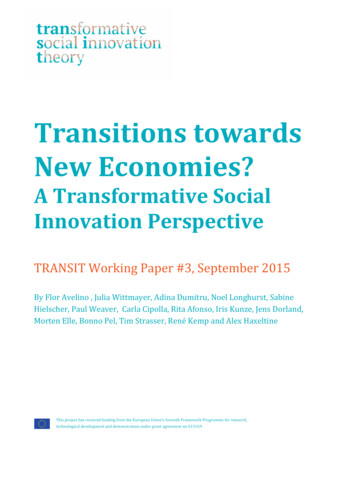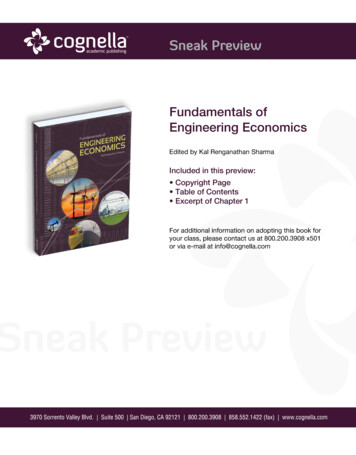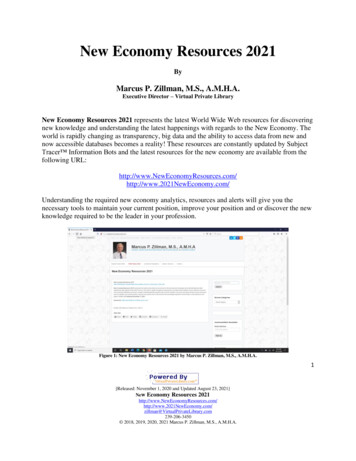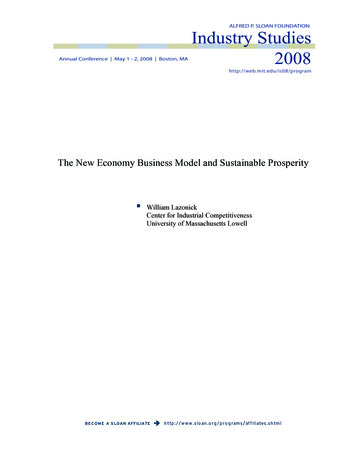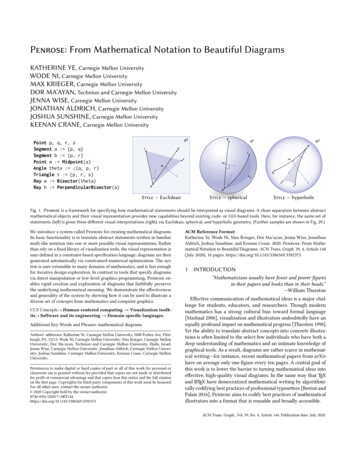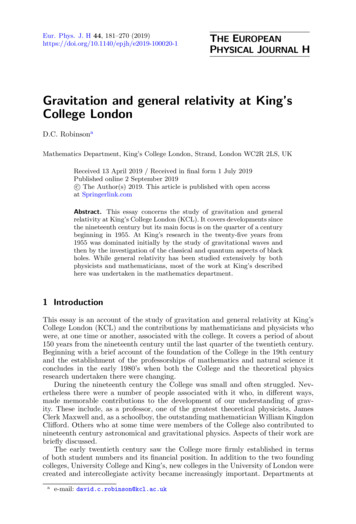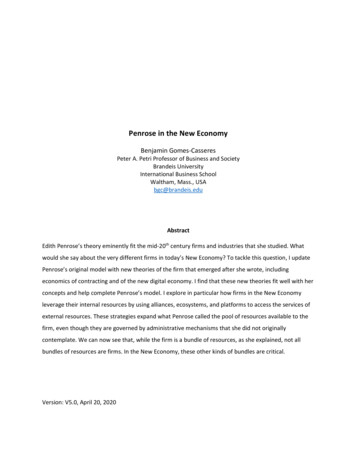
Transcription
Penrose in the New EconomyBenjamin Gomes-CasseresPeter A. Petri Professor of Business and SocietyBrandeis UniversityInternational Business SchoolWaltham, Mass., USAbgc@brandeis.eduAbstractEdith Penrose’s theory eminently fit the mid-20th century firms and industries that she studied. Whatwould she say about the very different firms in today’s New Economy? To tackle this question, I updatePenrose’s original model with new theories of the firm that emerged after she wrote, includingeconomics of contracting and of the new digital economy. I find that these new theories fit well with herconcepts and help complete Penrose’s model. I explore in particular how firms in the New Economyleverage their internal resources by using alliances, ecosystems, and platforms to access the services ofexternal resources. These strategies expand what Penrose called the pool of resources available to thefirm, even though they are governed by administrative mechanisms that she did not originallycontemplate. We can now see that, while the firm is a bundle of resources, as she explained, not allbundles of resources are firms. In the New Economy, these other kinds of bundles are critical.Version: V5.0, April 20, 2020
2When Edith Penrose wrote The Theory of the Growth of the Firm (TGF)1, firms like Du Pont, GeneralMotors, Standard Oil represented the pinnacle of the American economy. Her analysis was based onthoughtful observation of their practices, specifically those of the Hercules Powder Company. Hertheory eminently fit these mid-20th century firms and industries.Our economy today is ruled by new kinds of firms in new industries. The leaders in the new digitalindustries -- the New Economy for short -- are firms such as Intel, Microsoft, Google, Amazon, andFacebook. Smaller firms like eBay, Uber, and Airbnb offer equally important models that are differentfrom the old firms.What would Penrose say about this new industrial landscape? Does her analysis need revision for the21st century firms and industries?I will examine these questions from a distinct angle; I won’t cover all of Penrose’s thinking. I will focus onhow firms leverage their internal resources by using alliances, ecosystems, and platforms to access theservices of external resources. These strategies expand what Penrose called the pool of resourcesavailable to the firm, even though they are governed by administrative mechanisms that she did notoriginally contemplate.In Penrose’s last writings before her death in 1996, she expressed fascination at these new trends, butdid not have a firm grasp yet on them or on how they fit her theories (Penrose chapter in Warner 1996).I was fortunate to have met her and corresponded with about my own work on alliances. I base myanalysis on that interaction, as well as on a close reading of her last writings and of the reports of herbiographers and reviewers (Penrose and Pitelis 2009; Kay 1999).Section 1. How to Update the Penrose’s ModelTo “update” Penrose, we need to consider not only new evidence, but also new theory. A lot haschanged in economic and management thinking from the 1950s to today. In particular, the theory of thefirm has been revamped with a new focus on contractual economics both inside and outside the firm.These theories are particularly relevant to alliances, ecosystems, and platforms. Here again, Penrose’s1Referred to below as TGF, the book was published in 1959; the third edition, published in 1995, contains a newforeword by Penrose; the fourth edition, published in 2009, contains an excellent introduction by Christos Pitelisand reproduces Penrose’s foreword to the third edition as an appendix. Citations here are from the 2009 edition(Penrose and Pitelis 2009), but refer to her 1959 text, her 1995 foreword, or to Pitelis’s introduction, as noted.
3last writings suggest that she too saw this relevance and was pondering how to work these new theoriesinto hers.Given that there is both empirical and theoretical “news” to mix into Penrose’s model, I will separatethe two and proceed in steps. Figure 1 shows the territory to be covered. Edith Penrose used theeconomics of the 1950s to tackle questions that arose in the firms and industries of the era (bottom leftquadrant). We will extend her model in two directions. Section 2 asks how her original model applies totoday’s firms (bottom right). Section 3 asks what the new theories of the firm add to her model, even ifapplied just to Hercules and its ilk (top left). After that, Section 4 combines these two avenues toconsider how an updated Penrose model would apply to our current era (top right). Section 5 concludeswith a question that Penrose raised in her last writings: Is the firm itself undergoing a metamorphosis,turning into something totally new?[Insert Figure 1 here]Before embarking on an update of Penrose’s original model, it is worth restating here its key features.As noted, we focus here on those aspects of the original model that will be relevant to how firms useexternal resources. We will highlight certain gaps in her model, not to point fingers, but in order to openup avenues for further thought.1.1. The firm as an administrative organization and a pool of resources. The common reading of TGFtoday is that it defines the firm as “a collection of resources bound together in an administrativeframework” (Foreword to the Third Edition, in Penrose and Pitelis 2009, p. 236). It is worth pointing out,however, that the link between these two key concepts -- the pool of resources and the administrativeorganization -- is not always clear in the book itself. These concepts first appear in the book as twoseparate sections (Penrose and Pitelis 2009, pp. 13-21 and 21-23). In Penrose’s published case study ofHercules, she summarized the argument of the book: “A firm is both an administrative organization anda pool of resources” (Penrose 1960, p. 2. My emphasis).“And” is a weak statement about a relationship between two concepts. What is missing is a notion thatthe administrative organization of a firm exists to govern the pool of resources. Without this link -- “togovern” – Penrose’s two key concepts merely live in parallel. Implicitly, it she probably meant to say thatadministrative decisions drive the use of resources in a firm. But she does not ask in TGF how this linkworks. Had she asked this question, it would have likely drawn her into consideration of how ownership
4works, how contracts work, and how other forms of authority influence the use of resources. We willreturn to this missing link in Penrose’s original model in Section 3.1.2. The administrative boundaries of the firm. In TGF, Penrose defines the boundary of the firm interms of its administrative reach, not its ownership of resources: “The essential difference betweeneconomic activity inside the firm and economic activity in the ‘market’ is that the former is carried onwithin an administrative organization, while the latter is not” (Penrose and Pitelis 2009, p. 13). Thissounds simple, but it isn’t. The statement leads her into a discussion of what kind of administrativeorganization counts when defining the firm. For example, she concludes that mere financial ownershipdoes not define the boundary, as investment trusts are not firms in her sense. From this she concludesthat “it is the ‘area of coordination’ – the area of ‘authoritative communication’ – which must define theboundaries of the firm” (Penrose and Pitelis 2009, p. 17-18).Even with this definition, the external relations of a firm appear to her as a grey area. She writes that“long-term contracts, leases, and patent license agreements may give an equally effective control, andyet cannot be easily treated in the same way (Penrose and Pitelis 2009, p. 18).” She does not say whythey cannot be compared to intra-firm authority or treated in the same model. We will return to thisblurry firm boundary in Section 2.1.3. No inkling of the contractual theory of the firm. To our modern ears, Penrose’s missing link aboutgovernance and her vague definition of firm boundaries cry out for application of what we now know asthe contractual theory of the firm. Why did she not include these ideas in her study? After all, RonaldCoase had introduced the idea over twenty years before (Coase 1937). Does it somehow not fit? I don’tthink that is the case.The answer to why Penrose didn’t cite Coase seems to be: Nobody (who mattered in Economics) knewof Coase! Fritz Machlup, Penrose’s thesis supervisor, wrote two texts on industrial organization in themid-1950s, neither of which mentioned Coase. A decade later, Machlup delivered his presidentialaddress to the American Economic Association on the very topic of theories of the firm. In it, heexhaustively listed ten concepts of the firm, none of which included contracting or transactions costs -and Coase was nowhere in his long bibliography (Machlup 1967).In his Nobel lecture Coase himself later wondered why it had taken so long for his now-classic article toenter the mainstream (Coase 1992). He attributed its rediscovery in part to the later work of Oliver
5Williamson and others. Whatever the reason for the delay, the contractual approach is now entrenchedin our conception of the firm. Furthermore, even if it was not on the horizon for Edith Penrose in the1950s, she did recognize its importance in her last writings, as discussed later.1.4. Measuring the size of the firm. Given the above, it comes as no surprise that it is hard to measurethe size of the firm by Penrose’s definitions. How much administrative authority defines the boundary ofthe firm? What resources do we include or exclude from the pool that defines the firm? Penroseappears not to have been too bothered by these measurement questions, perhaps because she was notconducting an empirical analysis of multiple firms. Most of her evidence came from the Hercules PowderCompany, a firm that was by all accounts well-defined – it owned most of its businesses outright and itsactivities were all closely related in terms of production and customers. Having myself interviewedmanagers at Hercules for my doctoral thesis thirty years after Edith Penrose did so, I can well imaginethat they would have had little patience for questions about what is or is not inside their firm.Penrose thus quickly settled on a proxy to measure the size of a firm, since the subject is obviouslyrelevant. Ideally, she said, size should be measured as “the present value of the total of its resources(including its personnel) used for its own productive purposes” (Penrose and Pitelis 2009, p. 22). Shesurely meant not the NPV of the resources as assets, but the NPV of the stream of services they provide,a concept she had just explained in a preceding paragraph. Today, we might equate this with the marketcapitalization of a public firm, which in theory equals the NPV of the firm’s future cash flows. For somereason, she did not select this proxy, but instead chose fixed assets as a reasonable measure of firm size.With all the emphasis on managerial resources in TGF, this seems like a narrow measure. Fortunately,this measure did not restrict Penrose from thinking of firm growth in other terms – particularly, thegrowth of the pool of resources and of the administrative reach of the organization. We will return tothese measures in Section 2.Edith Penrose’s original model of the growth of the firm was a masterpiece – it reframed classic topics ineconomics in ways that invited in concepts from the then-emerging literature in management. Her workwas based on real-world observation, not on ideal types. At the same time, it can bear extension andrevision. Times have changed and the best thinking in the field has changed. What follows builds onPenrose’s achievement and attempts to strengthen her framing and intent.
6Section 2. How New Economy Firms Stretch the Penrose ModelTo see if Penrose’s ideas apply today, let’s start with the data, as she did. Hercules is no longer abellwether of the American economy, as it was in 1960. At that time, it was a medium-sized (165th onthe Fortune list) chemical producer that was hitting its stride and seems to have been attractive toinvestors. It produced a closely related set of products, sold to other businesses. (Penrose 1960.)2.1. What do New Economy firms look like? Today’s iconic firms are a world apart from Hercules in1960. Table 1 shows selected financial statistics for Hercules in 1960, and for Ashland Global (Hercules’ssuccessor) and seven New Economy firms in 2018-2019. From left to right, the table shows marketcapitalization, sales or revenues, total assets, and number of employees. We should take these numbersas rough indicators, since some of them move around a lot, and financial years and definitions vary. Wewill focus on the ratios calculated from these basic measures, shown in columns 5 through 9. The neweconomy firms are sorted by growth rate.[Insert Table 1 here]Let’s examine this table in reverse -- from right to left, starting with the yearly growth rate of revenues(column 9). By Penrose’s telling, Hercules in 1960 had not grown so fast as some other firms in its field,but faster than its industry as a whole. She estimated the growth of fixed assets at around 5%, thenumber shown in the table. Fast forward to today, and we see Hercules’s successor firm shrinking notgrowing (by revenue).And the New Economy firms are booming, especially the newest ones. Facebook’s growth wasexplosive, while Amazon, Google, and Apple grew at double digits; Microsoft, Intel, and eBay by nowseem to be more mature, like perhaps Hercules was in its day. How did the new firms grow so fast?Penrose predicted that there was a limit to the rate of growth of firms, not to their size. Have there beenno such limits for Facebook, Amazon, Google, and Apple? The rest of the tables provides some clues.The fast-growing new firms have high valuations in the market (col 6), but Hercules in its heyday was notout of line with them in this sense. What is different for the new firms is their high sales per employee(col 7) and their high capital-labor ratio (col 5). On these two counts, Facebook, Google, and Appleoperate with much fewer personnel than Hercules did in 1960 and than Ashland does today. (Amazon ismore similar to Hercules in this sense, but in this sense only.)
72.2. How network externalities drive growth. Did firms like Amazon, Google, and Apple break throughor skirt the “Penrose effect,” whereby the growth of a firm is limited by the rate of growth of resources?(Uzawa 1969; see a more recent treatment in Vidal and Mitchell 2018.)? Not necessarily.First, because of their high capital intensity, financing would be their most pressing need in order togrow, less so management personnel. Capital was available because of their high valuation, which, in acircular manner, was so because of the firms’ high growth rates. Management would seem to have beenavailable and able to be “stretched” rapidly, for reasons we will examine in a moment.The second reason why the firms grew fast despite a possible Penrose effect is because their productionfunction differed from that of traditional industrial firms like Hercules. New economy firms benefit fromeconomies of scale not only in production, but also in demand. What we now know as networkexternalities make their product more valuable to the buyer, the more of it is sold (Shapiro and Varian1999; Goldfarb and Tucker 2019). This feature led to the “get big fast” strategies of New Economy firms,and also to their acquisitions to gain or protect market share. These network externalities were notunique to the New Economy or to the 1990s and 2000s; they were important in earlier standards battlesin video-recording, CDs, and other technologies. At the same time, the New Economy firms we areexamining here relied more on these effects than previous leading firms, and certainly more than theleading chemical and industrial firms in Penrose’s day.In essence, these network effects meant that consumer value was created by growth itself, leading tostill higher sales, higher valuations, and easier access to capital, which in turn enables further growth.These demand-side economies of scale mean that growth was “pulled” by external factors. Penrose didexplain how growth can be limited or encouraged by external market opportunities, but could notforesee the increasing returns to scale in demand that only became common in the last decades. I callthis a different “production function” from the traditional one because the relationships between inputsand outputs is different than what Penrose observed.Network externalities in effect create an additional factor of production – individuals themselves, asconsumers and producers. The so-called Web 2.0 businesses that arose after the internet wasestablished notoriously use data and inputs from consumers to sell products and services to others, andto the same consumers. Facebook is a prime example, as are Airbnb, eBay, and Uber. In each case, thenumber of consumers or producers increases the value of the product to each consumer.
82.3. How alliances expand managerial resources. There is another way in which the production functionchanged in the last few decades, and it is consistent with Penrose’s predictions. She explained how firmswould have to go outside of their boundaries to acquire new resources if they wanted to grow fasterthan their internal resources allowed. She considered managerial talent, personnel, and entrepreneurialskills to be the chief limitations that might slow down a firm intent on fast growth Firms in her viewwould acquire and merge to gain the needed resources.The evidence suggests that the New Economy firms, too, acquired smaller firms as a way to expandedmanagerial and entrepreneurial resources. Often, these acquisitions came with kernels of new productsthat were then developed in the larger firm. Cisco, Google, Apple, and Microsoft followed suchstrategies.The New Economy firms also accessed external resources through deals short of merger or acquisition.Alliances are just that -- organizational mechanisms to govern an incomplete contract between firms, arelationship that is deeper than an arm’s length trade and short of a merger (Gomes-Casseres, 1996).The rate of alliance formation shot up during successive ways of innovation, as shown in Figure 2. Thechart shows the number of new alliances formed every year worldwide, according to Thomson Reutersdata. This source reports two types of deals – alliances that are purely contractual, and those thatinclude a component of equity investment, either in a stand-alone entity (classic joint ventures) or as aminority investment of one firm in another. These data are admittedly incomplete and the alliancedefinitions are perhaps legalistic, but they do cover a wide swath of industries better than any othersource (Schilling 2009). The chart shows several waves of alliance formation, punctuated by periods ofdeclining alliance formation. The first wave (1990-1995) corresponded with the rise of computerhardware and software – the heyday of Intel and Microsoft. The second wave (1996- 2001)corresponded with the rise of the internet and dot.com businesses, such as Amazon and Google. Thethird wave (2002-2007) corresponded to the rise of Web 2.0 businesses. After the great recession (20082010), the use of alliances moderated, but a recent up-tick seems to correspond to deals in emergingtechnology industries (Saada and Gomes-Casseres 2018). Over these decades, the alliances ininformation technology, biopharma, and media industries were mostly contractual, with equity jointventures being more common in traditional industrial sectors like automobiles, retail, and energy.[Insert Figure 2 here]
9In some industries, like biopharma, alliances are today as important as internal spending in developingnew products. These alliances allow faster expansion of a business in part because they bring theservices of external resources that would be time consuming or impossible for the firm to develop, justas Penrose predicted for growth by acquisitions.These alliances also release another constraint on growth that Penrose did not foresee. Her model oftechnical progress was colored by the chemical industry, where each product is valued by buyers for itsinherent material features. Many of the new economy industries, however, are based on systems ofproducts (Shapiro and Varian 1999), in which the value of one product depends on the buyer also usinga complementary product – say, hardware and software. This means that the growth of one firm may belimited or encouraged by the growth of firms making a complementary product. Microsoft and Intel areprime examples -- each has needed the other to grow, and so their alliance has helped coordinate theiractions (Yoffie, Casadesus-Masanell, and Mattu 2004).These complementarities give rise to ecosystems, which I define as simply a set of companies linkedtogether by alliances (Gomes-Casseres 2015; for a narrower definition, still consistent with theargument here, see Jacobides, Cennamo, and Gawer 2018). In her later work, Penrose shows interest inthese networks and relates them to work on geographic “clusters.” The notion of ecosystem that I usehere is not necessarily bound by location, so not a cluster in that sense. The ecosystem of allied firms insystems businesses are usually global, and link firms that are adjacent to each other in the industrial orfunctional sense.Penrose did not foresee these complementarities in the markets she studied, and so did not strugglewith the question of how to govern resources that are needed to exploit them. She did observe thatHercules had a joint venture (Penrose 1960, p. 16), but did not explore why the firm chose that way togovern the relationship, as opposed to an acquisition. We will return to this point later, as neweconomic theories help us understand the choice.2.4. How digital code and platforms stretch managerial resources. There is one last way in which theNew Economy firms were able to defeat the Penrose effect. The very technologies they developed –digitization, communication, and data analysis – also enabled them to “stretch” their managerial andentrepreneurial resources as their businesses grew. As a result of this greater leveraging of their existingresources, the reach of their administrative authority could grow without the resources themselvesexpanding. How did they achieve this magic?
10The magic comes from code – the commands embedded in hardware and software that tell a systemhow to behave. In a landmark book, Larry Lessig explained how in the digital age, code shapes behaviorjust as much as laws, norms, and markets do (Lessig 2001). The code embedded in our digital systems isthe architecture that guides our interactions. Think about Facebook – how their member pages arecoded determines who sees what, who can post what, and how members can communicate with eachother. In eBay, code shapes how price setting occurs. In every smartphone, code shapes how we relateto each other, buy things, get our news, and more.Because code shapes behavior, it can be used for administrative coordination, and to exercise authorityat a distance, so to speak. Managers in a firm can use code to implement organizational routines andpolicies, and today even to make decisions. This sounds like the ideal that Penrose described: “[O]nce anadministrative framework has been created . . . and once policies are laid down . . . no furtherintervention by the central management is required,” so long as the decisions to be made conform tothe established policies (Penrose and Pitelis 2009, p. 14). In this way, code can extend the reach of a“central management” just as policies and administrative rules would. Of course, to deal with change,one still needs personnel to make new decisions, at least until the code advances to true managerialintelligence.Having stated starkly this argument for how code stretches resources, we can now see how it appliesmore broadly to any “platform” business. The narrow definition of a platform business is one in whichdifferent market participants interact with each other in a digital space, where code sets the rules ofcommunication, search, matching, and even the terms of agreements between parties. eBay is a classicdigital platform. It is not surprising then that eBay achieved a market value seven times that of Hercules,with only 30% more employees, and even though it’s price-to-book ratio was lower than that ofHercules at the time In other words, it appears that the code in the platform extends the reach ofadministrative coordination practically for free.A broader definition of platform business is one in which technology sets the terms for interactionamong complementary firms. In this sense, the iPhone and Android platforms shape who can makewhat complementary product and how the product should work. More broadly, Intel and Microsoft’splatforms shape the interactions among their partners. One of the reasons behind Apple, Intel, andMicrosoft’s growth and success is that they defined their strategies in terms of platforms, rather thandiscrete products (Yoffie and Cusumano 2015).
11This idea too is one that Penrose would not have encountered in her research in chemicals – though shedoes see firms as developing distinct technological and market “bases” (Penrose and Pitelis 2009, pp.97-105). These bases shape how the firm’s resources are used, which markets are addressed, and whichacquisitions may be justified. But Penrose does not see them as mechanisms for extending the reach ofthe firm’s scarce managerial talent.With all these new phenomena to explain, does Penrose’s theory of the firm still apply? In short, herdescription of what firms are no longer rings as true. But the mechanisms of administrative governanceof a pool of resources are still there, even if they may work differently than she described. Penrose’sconclusions may need revision, but her way of thinking is still illuminating. It remains so, and even getsstronger analytically, when we introduce new ideas in economics.Section 3. Updating Penrose With New Theories of the FirmWe will consider now how Penrose’s original model can be extended with ideas from Coase and fromthe broader school of thought on the economics of contracts, which includes three other Nobel Prizewinners – Oliver Williamson, Bengt Holmstrom, and Oliver Hart. Although Edith Penrose didn’t knowabout Ronald Coase when she published TGF in 1959, she did know and appreciate Coase’s ideas whenshe wrote her preface to the third edition in 1995. That preface was one of her last published writingsand it shows her keen interest in many new schools of thought.3.1. Edith, meet Ronald. Penrose’s other last piece of writing is a more complete statement abouttheory than the preface, but it is hard to locate – you have to go to the library for it. Her chapter on“Growth of the firm and networking” in the multi-volume International Encyclopedia of Business andManagement (Penrose in Warner 1996) is a rewarding read. In it, she states clearly how she thinks herwork fits with transaction-cost economics:Broadly speaking, there are two major types of explanations for the growth of firms in amarket economy. the two approaches ask different kinds of questions, thusemphasizing different considerations regarding the behaviour and nature of the firm.One explanation rests on an analysis of the role of market transaction costs. The otherexplanation starts with an analysis of the nature of the resources available to the firm.The two approaches are not mutually exclusive. (Penrose in Warner 1996, p. 2441.Emphasis is mine.)
12Saying that two approaches are “not mutually exclusive” is a weak statement of how they fit. At leastthey don’t conflict, she is saying. Penrose’s statement appears to imply that the two schools of thoughtcan play in parallel, each doing its own thing in the theory of the growth of the firm.3.2. Ronald, meet Edith. I think that the link between the two approaches is much stronger than justparallel-play. In fact, Coase himself found the two more than just compatible. He wrote to ChristosPitelis, the foremost biographer of Penrose’s scholarship: “I do not regard her views as an alternative tomine in ‘The Nature of the Firm’ but as a necessary addition to it [T]here has been insufficientattention to the role of the firm in ‘running a business.’” (Pitelis Introduction in Penrose and Pitelis 2009,p. xxxii. My emphasis.)“Necessary addition” is a strong statement. A close reading of Coase’s classic article shows exactlywhere Penrose’s concepts would fit in his model:[T]he operation of a market costs something and by forming an organization andallowing some authority (an ‘entrepreneur’) to direct the resources, certain marketingcosts are saved. The entrepreneur has to carry out his function at less cost, taking intoaccount the fact that he may get factors of production at a lower price than the markettransactions which he supersedes. (Coase 1937, p. 392.)In other words – Penrose’s managerial authority is needed to run the organization that Coase’s arguesmay beat the market costs of a transaction. That is what Coase meant by “running the business.” Ofcourse, Coase himself did not explore that aspect of the firm, because he was focused on thetransactions generated by the firm’s activities. But, with hindsight perhaps, he might see Penrose’sworld as fitting snuggly next to his. In a way, it helps complete his model.The reverse is true too – Penrose’s model, in turn, depends on Coase’s ideas, even if she perhaps did nothave time to fully realize this. In her last piece, she wrote that transaction costs are important in twotypes of decisions: (1) whether two companies should merge, and (2) how firms are organized internally(Penrose in Warner 1996). Let’s examine each typ
Our economy today is ruled by new kinds of firms in new industries. The leaders in the new digital industries -- the New Economy for short -- are firms such as Intel, Microsoft, Google, Amazon, and Facebook. Smaller firms like eBay, Uber, and Airbnb offer equall


